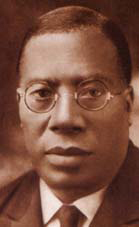History of Hymns: "Beams of Heaven as I Go"
"Beams of Heaven as I Go"
Charles Albert Tindley
UM Hymnal, No. 524
Beams of heaven as I go,
through this wilderness below,
guide my feet in peaceful ways,
turn my midnights into days.
When in the darkness I would grope,
Faith always sees a star of hope,
and soon from all life’s grief and danger,
I shall be free some day.
I do not know how long ’twill be,
nor what the future holds for me,
but this I know: if Jesus leads me,
I shall get home someday.
Charles Albert Tindley (1851-1933) was one of the eminent preachers of Methodism at the turn of the 20th century. In a collection of Tindley hymns, Beams of Heaven (General Board of Global Ministries, 2006) Emory University hymnologist James Abbington calls Tindley a “pastor, orator, poet, writer, theologian, social activist, ‘father of African American Hymnody,’ ‘progenitor of African American gospel music’ and ‘prince of preachers.’”
 |
|
Charles Albert Tindley |
“Beams of Heaven as I Go,” one of 47 hymns by Tindley, was originally titled “Some Day.” It first appeared in his collection New Songs of Paradise, No. 6 (1916).
The Rev. Carlton Young, editor of the UM Hymnal, cites African-American scholars C. Eric Lincoln and Lawrence H. Mamiya in describing the social conditions of the day surrounding this hymn: “Tindley wrote songs incorporating the black folk imagery which attempted to interpret the oppression African Americans faced as they settled in the cities of the North, an experience not essentially different from that which produced the spirituals. The Tindley hymns (which are congregational songs) admonish those who suffer the storms of life to stand fast in Christ. . . . They are also addressed to helping the oppressed to survive this world.”
With this background, one can sing the hymn with deeper understanding.
In stanza one, Tindley compares life to a “wilderness below” in which we “grope” in “darkness.” The biblical roots of this stanza can undoubtedly be found in the Exodus narrative that describes Israel’s flight from Egypt through the wilderness and into Canaan. Interestingly, the second half of the stanza switches to a New Testament image: A “star of hope” appears in the “darkness,” perhaps a connection with the Magi in Matthew 2. The refrain then clarifies who guides us through this wilderness. We may feel lost, but “if Jesus leads me, I shall get home some day.”
Stanza two continues the image of light introduced by the star in the first stanza. Even when the “sky is clear” and “a day [is] so bright,” “clouds may hide tomorrow’s sun.” However, Tindley notes that “some day” we “shall behold” a place where “day never yields to night.”
The third stanza names evil (“wickedness”) and the power of Satan directly. The phrase—“Right may often yield to might”—are words of truth for any age. Then Tindley reminds the singer that even in this situation, “God . . . rules above, with hand of power and heart of love.” These words are perhaps the most poetic and powerful of the entire hymn.
One of Tindley’s gifts as a hymn writer is to name the pain and struggle boldly and then, using the poetic device of antithesis, offer an alternative vision of hope. The final stanza is a good example of this, reminding us that we carry “burdens [that] crush me down . . . [and we see] disappointments all around.” Then Tindley offers hope: “There is a world where pleasure reigns. . . .” Our destination is “to that land of peace and glory.”
The hymn writer’s theology is centered on life as a journey with a clear destination. While the aim is eschatological, this does not mean that Tindley did not want glimpses of heaven on earth. His hymns express a classic Methodist theology of heaven as the place of Christian perfection. However, life is a journey toward that perfection and John Wesley’s call to social holiness undergirds this journey—a concern for and involvement in the social issues and struggles of the day.
While the texts are usually written in the first-person singular, the “I” of the individual singer became “we” in the voicing of the song by the people. The struggles may have been felt individually by each person present, but they were shared by all as the congregation sang these hymns.
Dr. Abbington at Emory points out that Tindley often interpolated his hymns into his sermons. One can be sure that the message of the sermon labeled the injustices faced by the congregation and the hope that the gospel offers.
Tindley’s songs do not espouse a “pie in the sky by and by” theology, but instead they connect the struggles in the wilderness with hope. As we move toward our destination, we can also be hopeful that the injustices of this world will be addressed now.
His hymns were an extension of the spirituals, giving voice to the deep feelings of this earlier form and placing these feelings into the social context of the day. In turn, Tindley, often called the “father of gospel music,” influenced the next generation of composers including, as Dr. Abbington notes, Thomas A. Dorsey, Lucie E. Campbell, Roberta Martin, William Herbert Brewster and Kenneth Morris.
Dr. Hawn is distinguished professor of church music at Perkins School of Theology. He is also director of the seminary’s sacred music program.
Contact Us for Help
View staff by program area to ask for additional assistance.
